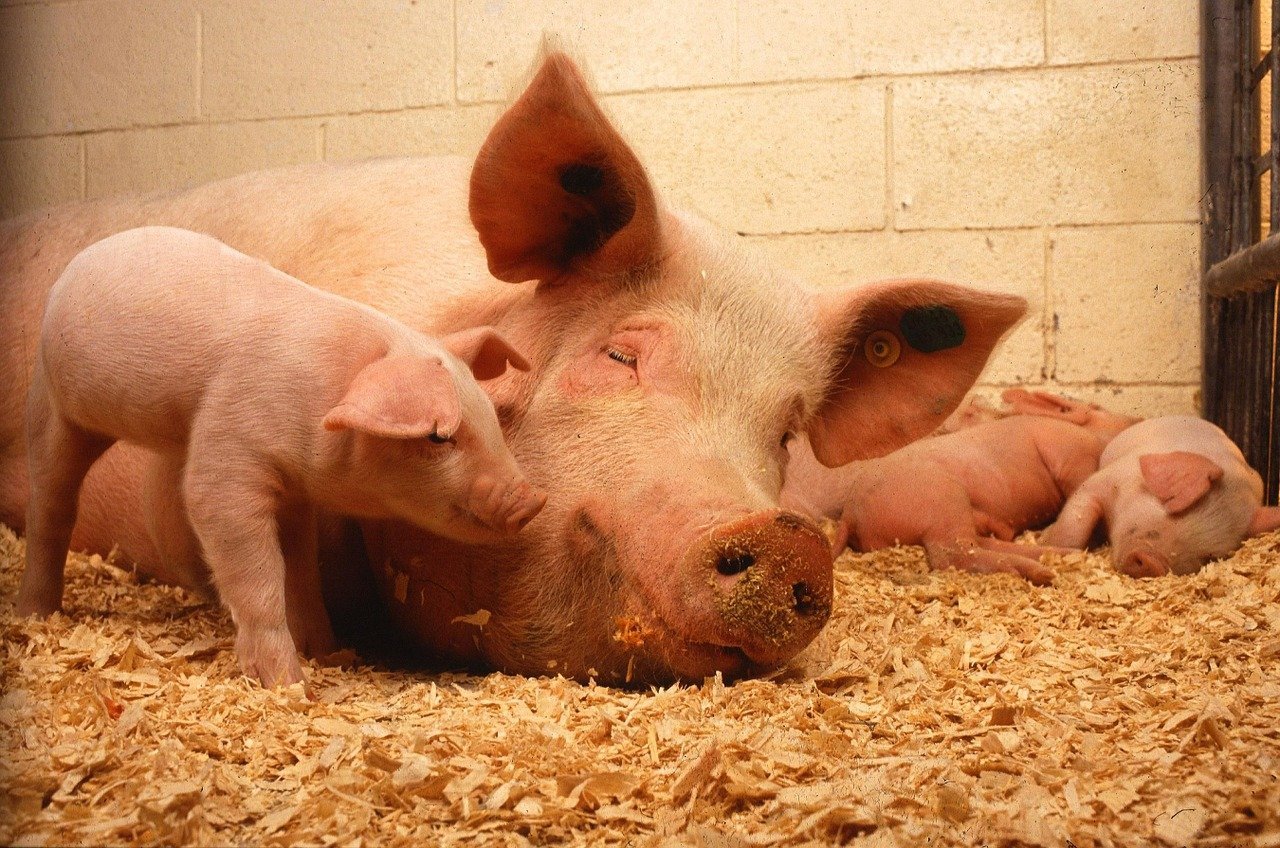Pig production has changed from the peasant system of allowing the animals to scavenge for food, thereby exposing them to attack of pests and diseases.
Modern pig farms are being established by both private and government at various levels and the management practices adopted include feeding, housing, care, and control of diseases as well as other well-planned practices that are essential for the increase in production.
Breeding Stock
The choice of breeders should be done at an early age of life.
Young pigs to be kept for breeding should be selected at the age of 3 months.
More pigs should be selected than the actual number needed since it is difficult to finalize which animals will be eventually required for breeding at an early age.
If important pigs are to be used, pigs with known history should be those to be accepted.
Factors responsible for choosing Pig Breeding Stock
The discussion below serves as a guide to factors that must be taken into consideration in making wise choices and selections.
There are about 7 factors in choosing to raise hogs and are health, size, defect, character, growth rate, reproductive, farm performance.
-
Health Status
Breeding stock selected, whether males or females must have excellent health status.
The health history is the main factor when selecting breeding hogs
They must not be taken from farms with contagious diseases or where parasite burdens are high.
Both of these health problems would be transferred with the stock.
Moreover, they could be slightly more resistant to recurrent bouts of illnesses from which they had recovered but for which there were lesions remaining within the body.
The breeding stock, therefore, undergoes rigorous tests.
Good health status is necessary, it is one of the factors to consider when selecting breeding boar.
Breeding stock must have been vaccinated and thoroughly dewormed to guarantee their future well-being.
-
Conformation
Breeding stock should be selected on the basis of conformation that ensures the best level of meat production.
Animals should be long, with well-developed musculature along the back and in the hams.
However, it should be remembered that such a musculature has to be carried on a strong skeleton which itself is essential for the various activities of the pig.
The skeleton may easily be assessed with reference to the legs.
These must be strong and well-positioned with big joints.
Considerable importance is attached to the hocks.
Straight hocks give the impression of well-developed hams; conversely, they result in a stilted gait and make movement more difficult:
The hind legs are poorly positioned and mounting during service is impeded if boars are heavy.
Therefore, hocks should be broad with an angled profile that guarantees articulation.
Because of the need to withstand heat, animals with a well-developed chest should be selected in preference to those with smaller chests.
-
Defects
Breeding stock should not possess any defects. This may seem self-evident but it’s not always so.
There are several defects that are genetically transmitted as dominant characters.
When there are genetic defects, even in the heterozygous state, they manifest as visible morphological deficiencies, thus, the transmission of defects is prevented.
However, this is not always the case, some genetic defects are transmitted recessively and are only evident with homozygous animals.
In pigs, for example, are scrotal or umbilical hernias and anal perforations.
If care is not taken, the defective gene will become progressively more common within the herd and the number of homozygotic individuals displaying it will increase.
Removal of defective animals is not sufficient, it is also necessary to eliminate the parents who may be carrying the defect recessively.
A boar may be tested by mating it with six of its sisters.
Defects should be avoided when selecting breeding boar.
If it is a recessive carrier, the defective character will be evident in one or more of the sisters and, of about 50 piglets born, a certain number will carry the defect homozygotically.
If there are none, the boar does not have the defect. This process takes time as boars are rarely mated before 2 years of age. However, for breeding stocks that are destined to be used extensively, such a precaution is wise.
-
Character
Control of calm animals is always easy. Animals with an inherent tendency to be unruly should not be used.
Therefore, the character is one of the factors to consider in pig raising.
It may not be the main factor but it’s important you acquire pigs with decent behavior.
-
Farm Performance
Breeding stock must show those favorable characteristics that are necessary for the success of the entire farm.
-
Growth Rate
This may be assessed in the animals themselves. Breeding stocks are selected from those animals whose growth rate is faster than their siblings.
This corresponds in fact to mass selection. It allows breeding stock to be judged before they reach puberty.
The genetic potential may also be assessed through progeny testing.
Growth rates of the male and female offspring from a given boar are measured.
Statistical analysis will indicate whether or not there is a genetic improvement.
This is an accurate method that is reliable but lengthy and may only be carried out in specialized centers.
At least 20 months are needed before the results of boar testing are available.
It is important to emphasize a major problem encountered with boar selection.
Castration is practiced on farms when pigs are between 4 and 5 weeks of age.
It is therefore at this age that the selection of entire animals must be made.
It is thus impossible to have anything other than a rough idea of their conformation as well as subsequent performance.
There is certainly a strong correlation between live-weight at one month and final live-weight and all those piglets with good conformation have better chances to do well during growth.
Thus if only one boar is required, then it is wise to maintain several good piglets until at least 60kg live-weight.
This makes an assessment of conformation and growth easier and only the best is kept.
Once breeding stock of both sexes has been selected, it is better to raise them separately.
It is recommended from this point onwards that their daily growth rates should be very rapid.
On the contrary, physical exercise is extremely valuable for good skeletal and muscle development as well as for flexibility of joints.
Daily access to a paddock for several hours where they can move about freely contributes to overall development and strength of limbs whilst at the same time restricting fattening.
-
Reproductive Qualities
One of the major attributes of the pig as a breed is that it is very fertile.
Maintaining a small number of breeding stock is sufficient to generate large numbers for fattening.
This is an important point to note. Each sow must produce sufficient piglets: 8-10 for gilts, 9-11 for subsequent litters.
Taking into account inevitable losses, this gives eight or nine piglets weaned per litter. It is important not to fall below this.
There is very little interest in large litter sizes of over 14 as milk production of sows is limited and many piglets will be weak. Mortality will also increase.
It is important to define which qualities are important.
Initially, the stock must be well suited to breeding – The boar must have a well-developed penis and testicles and the sow must have a normal vulva and at least 12 teats.
Finally, if it is impossible to judge animals on the basis of offspring, they may be selected on the basis of antecedents.
Breeding stock should be selected from the best animals within litters of at least ten piglets.
It is often considered, falsely, that selection should be based solely upon the best animals at weaning.
These almost solely upon the best animals at weaning.
These almost invariably come from small litters (five or six) and owe their size more to the amount of milk consumed.
Moreover, breeding from these animals would be associated with a reduction in litter size because of the inheritability of this characteristic.
Selection based upon antecedents must be followed up with reference to the first offspring.
Those gilts having litters smaller than seven piglets or who are unable to milk satisfactorily should be culled.
If the first litters from a young boar are consistently small, it should be also be called.
It could be that sperm quality is only mediocre, although this needs to be a foregone conclusion.
Some sows do not return to heat for some time following weaning. It is known that the hot climate is a factor contributing to this.
The selection of sows with regular oestrus cycles tends to favor those who are better adapted to heat.

Growing up in a family deeply rooted in agriculture, I developed an early passion for cultivating the land, caring for animals, and exploring sustainable ways to improve farm productivity.
I’ve worked extensively across multiple areas of agriculture, food and cash crop cultivation, poultry farming, fish farming etc.
At FarmPally, I enjoy sharing practical insights drawn from real-life experiences to help farmers, pet owners, and agriculture lovers make informed, and sustainable decisions.

